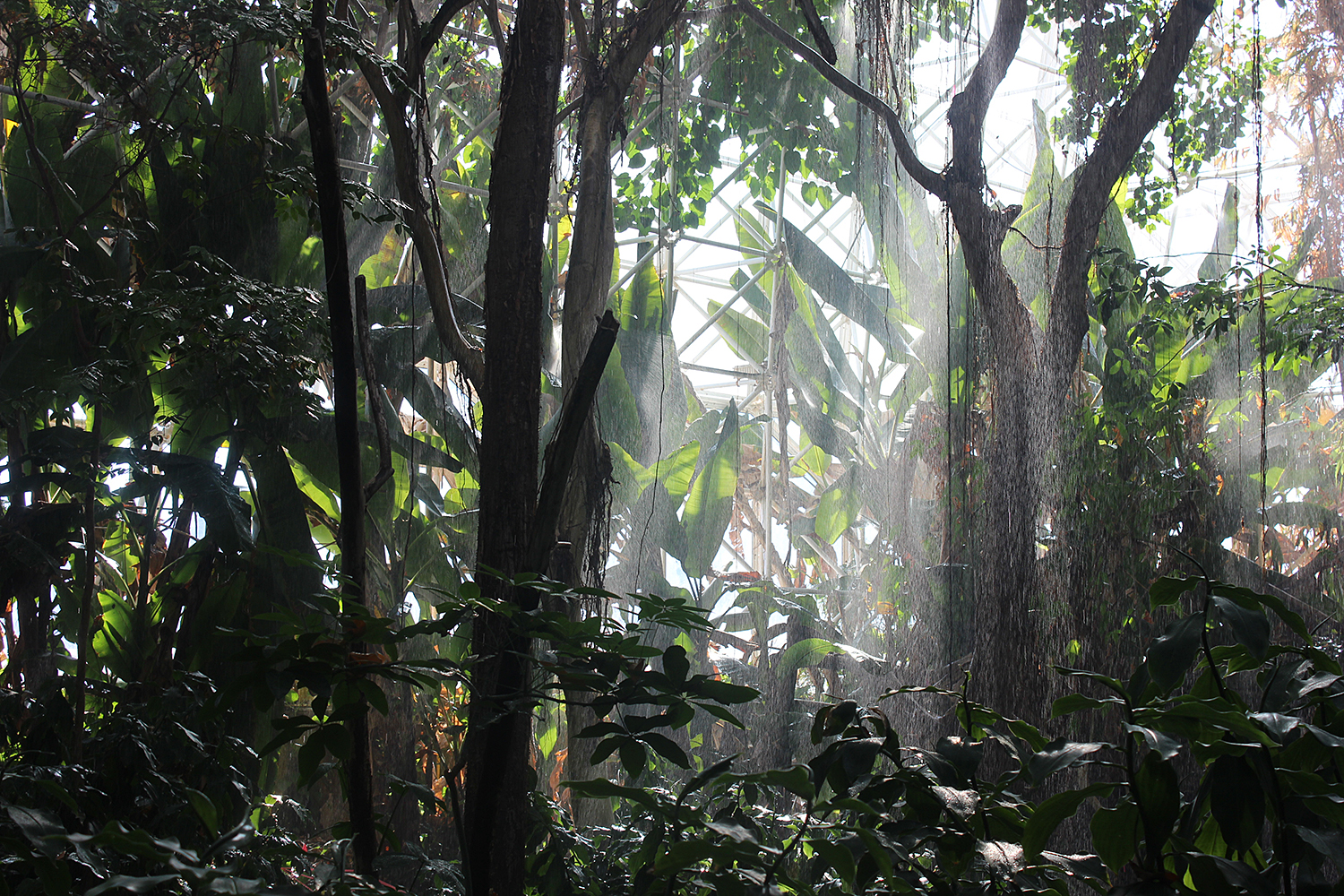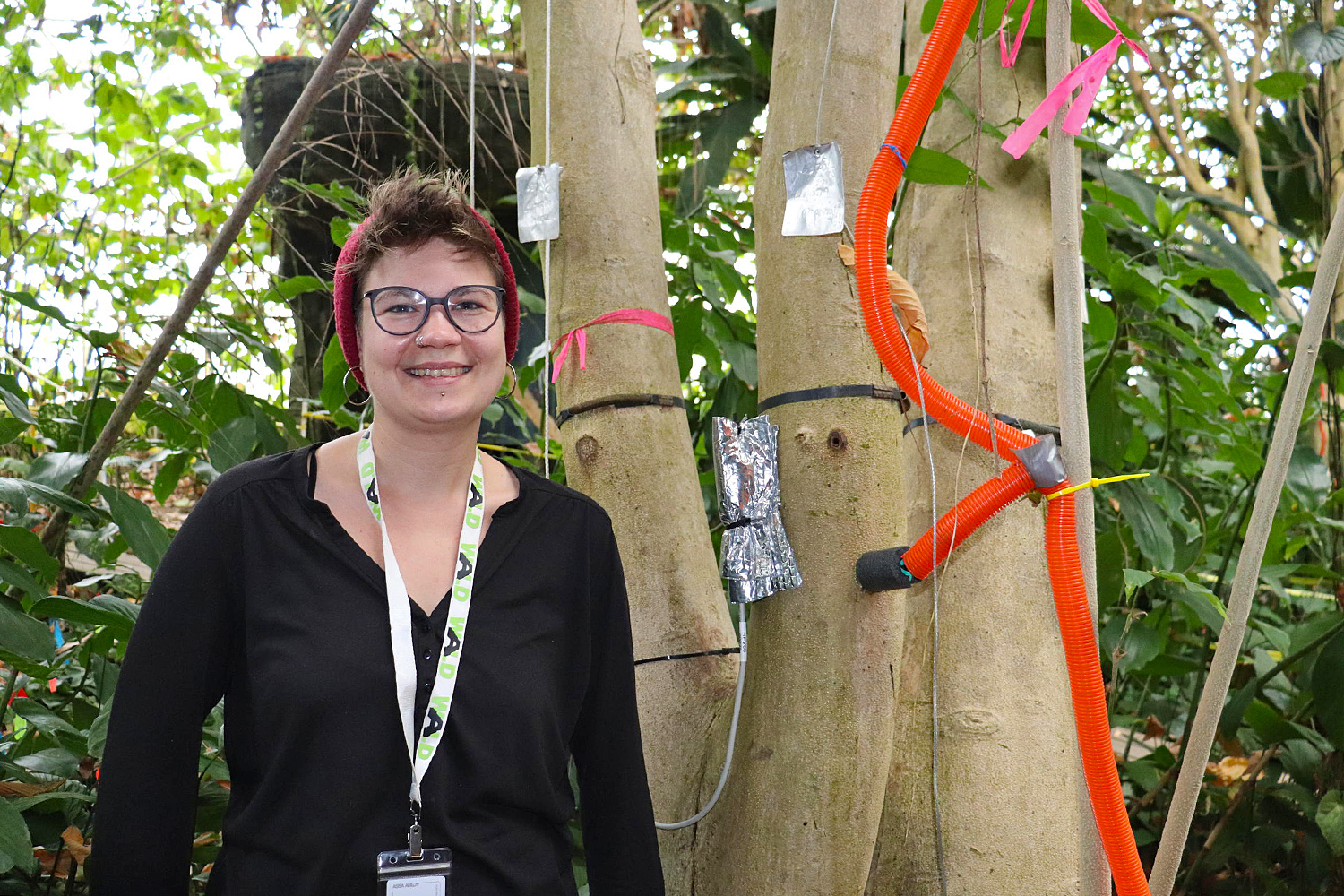The diversity of plants’ water use strategies makes forests resilient to extreme drought Largest tracer experiment to date in artificial rainforest Biosphere 2
Precisely how does a forest system and the individual plants within it react to extreme drought? Understanding the processes involved is crucial to making forests more resilient in the increasingly dry climate that will result from climate change, and also important for refining climate models. A research team led by Prof. Dr. Christiane Werner from the University of Freiburg, which also includes scientists from the Technische Universität Braunschweig, has conducted the most extensive experiment to date into this subject using stable isotopes to trace flows of water and carbon through a forest. To do this they exposed an enclosed, experimental rainforest in “Biosphere 2” (Arizona, USA) to a drought lasting 9.5 weeks and observed the specific strategies of different plants to cope with drought and their interactions with other plants, the soil and the atmosphere.

In the artificial rainforest. All atmospheric parameters in this ecosystem can be controlled. Picture credits: Kathrin Kühnhammer/TU Braunschweig
The integrated measurements revealed a complex interplay among trees and plants with differed adaptations to drought, which was crucial for maintaining the stability of the entire forest system for as long as possible. In addition, the experiment provided insights about how drought affects carbon storage within forests and how gas emissions from drought-stressed plants can influence the atmosphere and the climate.
Coordinated with Dr. Nemiah Ladd (University of Freiburg) and Dr. Laura Meredith (University of Arizona), the experiment took place in the US Research Center Biosphere 2. The international and interdisciplinary team included 80 scientists.
Dr. Matthias Beyer: “It was a crazy experiment.”
Researchers from TU Braunschweig were also involved: Dr. Matthias Beyer, head of the junior research group Isodrones at the Institute of Geoecology (AG Prof. Harald Biester) coordinated the “Water Group“, in which several scientists carried out all investigations relevant to the water cycle. “This was a crazy experiment, and I am very glad that Prof. Werner took us on this adventure. It was a unique opportunity for us to supply an entire ecosystem with labeled water ‘from below’ during a drought and to observe how this water is taken up by plants from the soil, transported to the leaves and finally released into the atmosphere.”
With their experiment the researchers identified four groups of plants with different responses to the imposed drought: drought-tolerant and drought-sensitive canopy-forming trees, and drought-tolerant and drought-sensitive understory plants.
Results of this study may help make forests more resilient
“We observed one of the most astonishing dynamics between the large drought-sensitive and drought-tolerant trees,” explains Christiane Werner. Sensitive trees are the ones that generally take up most water, especially from the topsoil. As topsoil is also fastest to dry out, these trees began to suffer sooner and had the most intensive water deficiency. The previous assumption was that they would switch to taking up water from deep in the soil, to maintain their high consumption rate. “But instead,” Werner says, “they restricted their water consumption drastically and only drew on the deep soil reservoirs under very extreme drought. So, they preserved the deep reservoirs for as long as possible, allowing it to still be available for drought-tolerant trees.” And those drought-tolerant trees in turn, because of their naturally lower water flow, retained their leaf canopy for longer, which then preserved the moisture in the understory longer. The maintenance of the understory helps to counter a dry-out of the topsoil, on which drought-sensitive trees massively depend. Overall, this complex interaction retains the water in the entire system and thereby keeps it stable for longer.
“This reveals,” Werner says, “that plants can develop different and at the same time complementary hydraulic strategies in a forest system – and with this interaction boost the resilience of the entire forest to drought. By learning more precise details we can make a substantial contribution to helping forests be more resilient to climate-related drought.”
How H2O, CO2 and VOCs flow through drought-stressed plants and soil
The researchers studied the flows of H2O, CO2 and volatile organic compounds (VOCs), such as isoprene and monoterpenes, to obtain their results. To do this, they fed labeled 13CO2 and 2H2O into Biosphere 2 and then tracked how these substances were partitioned between the trees, understory plants and soil over the course of the experiment. In this way the scientists observed, among other things, the intensity of water consumption and flow rate in the plants, the regions of the soil from which they drew water and at what times, and how CO2 and VOCs were stored in the plants and soil or emitted into the atmosphere. This was the first time such a tracer experiment has been carried out in an entire forest, something that is only possible within the contained system at Biosphere 2.

Kathrin Kühnhammer with one of her wired trees. The group led by Dr Matthias Beyer and Kathrin Kühnhammer is one of the first in the world to measure stable water isotopes in situ – i.e. directly in the field – in the trunk of trees. Picture credits: Kathrin Kühnhammer/TU Braunschweig
PhD student Kathrin Kühnhammer from Beyers research group spent a total of 3 months in Biosphere 2 recording water stable isotopes in soils and in the trunks of trees in high temporal resolution. From these data, researchers can track the change in water uptake depths of different trees during the experiment and determine which tree individuals had access to deep labeled water. This provides important clues about the adaptability of forests to changes in water availability. “All of the canopy-forming trees had access to the water provided ‘from below’ after the drought period – at a soil depth of 3-4 meters. That was quite a surprise to us.”
Results may refine climate models
When looking at the storage and emission of CO2 and VOCs, the researchers noted among other things that the forest’s carbon storage reduced by about 70 percent, and as drought stress increased, the plants emitted more VOCs, which can lead to the formation of ozone and other gases through interactions in the atmosphere. In addition, there was a cascade of emissions of various VOCs, such as isoprene, monoterpenes and hexanal, reflecting the increasing drought stress. Monoterpenes in particular can promote the condensation of clouds and thus lead to rain, probably acting as another protective mechanism against drought.
“All these findings are important to climate research,” says Christiane Werner. “Understanding what water use strategies plants deploy during drought and how they interact with other plants, with the soil and the atmosphere – all this can make modeling-based studies of climate change more precise in future”.
The international and interdisciplinary research team includes many specialists including hydrologists, ecophysiologists, microbiologists, ecologists and atmospheric researchers. “This broad expertise has, among other things, allowed us to better understand changes in processes at the microscopic level, such as molecular processes in cells and microbes, right up to ecosystem scale processes that influence the composition of the atmosphere,” says Werner. The research is part of her ERC Consolidator project. Matthias Beyer and his research group at TU Braunschweig are funded by the Volkswagen Foundation.
Joint press release of the Albert Ludwig University of Freiburg and Technische Universiät Braunschweig
